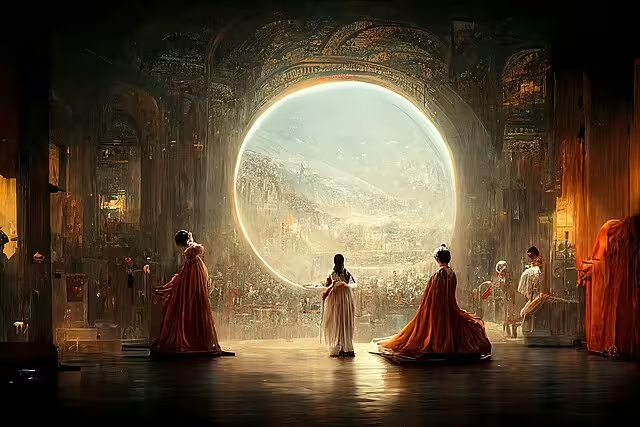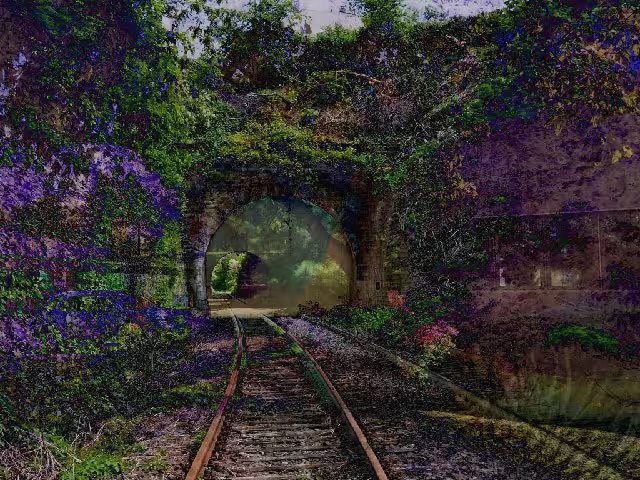In September 2022, ‘Théâtre D’opéra Spatial’, a work submitted by Jason Allen, won Colorado State Fair’s annual fine art competition in the digital art category. What made the success noteworthy was that the image had been AI-generated. Mr Allen eventually tried to register the work with the US Copyright Office but his attempts turned out fruitless. In September 2023 the Office refused his registration.
 First, ‘Théâtre D’opéra Spatial’ by Jason M. Allen.
First, ‘Théâtre D’opéra Spatial’ by Jason M. Allen.
Second, ‘A Recent Entrance to Paradise’ by Steven J. Thaler’s Creativity Machine.
I didn’t think much of it at the time. I wasn’t that invested in the consideration of what kind of ‘two-dimensional artworks’ are protected by copyright and, more notably, I somewhat agreed with the decision. Perhaps the prompt was protected, but if only minor manual edits were made to the image, it felt like a stretch to say the image as a whole could be covered by copyright law.
An entrance to paradise
‘Théâtre D’opéra Spatial’ wasn’t the first time US Copyright Office dealt with computer-generated images. Back in 2016, Steven Thaler’s Creativity Machine created a series of images with one of them — ‘A Recent Entrance to Paradise’ — ending up under the Office’s deliberation. The result was the same: in February 2022, the Office refused the registration.1 I was made aware of the image only after Leonard French, a US copyright attorney, made a video about the case. In it, he made the following comparison to photography:
Maybe [Thaler] could have argued that he had to select what images got put into the AI to create the output. Maybe he can argue that there was some creativity in selecting the images and choosing the setting for the AI very much like we have protections for photographs because there is at least minimal human creativity in choosing what to photograph, with what lens, what focal length, what focus, what iris or aperture, what shutter speed, and then what post-processing settings to use. That’s enough. It’s maybe not that much, but it’s enough to reach copyright protection.
This made me wonder what actually is the minimal human creativity that’s required for a work to be subject to copyright.
The lazy tourist
 An uninspiring photo made with very little human creativity which nevertheless meats criteria for copyright protection.
An uninspiring photo made with very little human creativity which nevertheless meats criteria for copyright protection.Specifically, consider a lazy tourist. In his travels, he ends up on a beach and notices a flock of birds in the water. He decides to take a photo of them with his mobile phone. A marvellous device makes taking photos a seamless experience — no need to pick any settings, the phone automatically chooses all of them. The tourist is a lazy one so he’s not going to walk too far to find a perfect framing. He wonders a few steps, points his phone and makes a new work covered by the copyright.
How much human creativity was there in this process? The subject of the photo wasn’t carefully planned. The tourist didn’t wake up one day deciding to make a photo of a flock of birds in the water. He just stumbled upon them. The choice of the subject was highly constraint without room for much creativity.
Similarly, the tourist chose the framing but here again the options were limited. He didn’t use a drone to make an aerial shot, waited patiently for perfect composition nor looked for interesting framing with other elements in the frame. The whole process took him just a couple of minutes.
And with the amount of automation in mobile phones, the tourist had no creative input into the settings of the camera or post-processing steps. And despite all that, the photo is covered by the copyright.
The prompter
Compare that to someone entering prompt into a text-to-image tool such as Stable Diffusion. There are countless possibilities of subjects to create images of. Flock of birds in the sea? Why not weyr of dragons in space? Or giant frogs on stills devouring humans? Similarly there are many options for framing. Is the subject of the image seen from the ground? From above? Are there foreground elements which obscure the subject?
And on top of that came all the settings that need to be tweaked to produce half-decent AI-generated image. Multiple models to choose from, samplers, guidance scale, control nets and so on.
Conclusion
AI is a controversial topic; there are many aspects of it that can lead to heated discussions. It’s not clear whether using publicly-available data to train the models is fair use or not. It’s also not clear whether a model which can reproduce letter-for-letter copyrighted works isn’t infringing in the first place.
Similarly copyrightability issue is hardly settled. The registration request for ‘A Recent Entrance to Paradise’ doesn’t tell us much since it claimed computer as the author. And in case of ‘Théâtre D’opéra Spatial’, the US Copyright Office did ‘not foreclose Mr Allen’s ability to file a new application for registration of the Work in which he disclaims the Work’s AI-generated material. In such a case, the Office could consider whether the human-authored elements of the Work can sustain a claim for copyright, an issue we have not decided here.’ Similarly, Leonard French theorised in his video that ‘maybe there is a point where an AI generated work could be protectable if there was enough creative human input on the input side or if you did that on the output side and created something with the AI-generated work.’
We’re many lawsuits away from having a clear picture of what kind of AI-generated works will be covered by copyright, but the position that photos made with a phone can be protected while images created with generative models cannot is inconsistent. The latter entails a lot more creativity and skill than majority of copyrighted photographs taken each day around the world.1 A notable difference is that Dr Thaler didn’t claim he was the author of the work. Rather, he argued that he hired the Creativity Machine to produce the images. Since copyright protections require human creativity, the outcome of the registration attempt was doomed to fail from the onset. I may be reading too much into it, but my guess is that Dr Thaler was more interested in exploring the idea of machines being creative and authoring works rather than getting copyright protections for the image. ↩